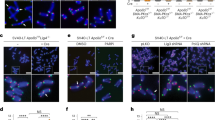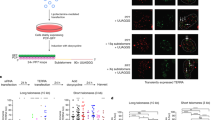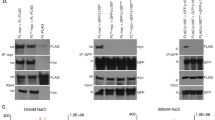Abstract
The telomerase enzyme lengthens telomeres, an activity essential for chromosome stability in most eukaryotes. The enzyme is composed of a specialized reverse transcriptase and a template RNA (ref. 1). In Saccharomyces cerevisiae, overexpression of TLC1, the telomerase RNA gene, disrupts telomeric structure2. The result is both shortened telomere length and loss of a special chromatin structure that normally silences telomere-proximal genes. Because telomerase function is not required for telomeric silencing, we postulated that the dominant-negative effect caused by overexpression of TLC1 RNA originates in a normal interaction between the RNA and an unknown telomeric factor important for silencing; the overexpressed RNA presumably continues to bind the factor and compromises its function3. Here we show that a 48-nt stem-loop structure within the 1.3-kb TLC1 RNA is necessary and sufficient for disrupting telomeric silencing and shortening telomeres. Moreover, this short RNA sequence appears to function through an interaction with the conserved DNA end-binding protein Ku (ref. 4). We propose that, in addition to its roles in telomeric silencing, homologous recombination and non-homologous end-joining (NHEJ), S. cerevisiae Ku also helps to recruit or activate telomerase at the telomere through an interaction with this stem-loop of TLC1 RNA.
This is a preview of subscription content, access via your institution
Access options
Subscribe to this journal
Receive 12 print issues and online access
$209.00 per year
only $17.42 per issue
Buy this article
- Purchase on Springer Link
- Instant access to full article PDF
Prices may be subject to local taxes which are calculated during checkout




Similar content being viewed by others
References
Bryan, T.M. & Cech, T.R. Telomerase and the maintenance of chromosome ends. Curr. Opin. Cell Biol. 11, 318–324 (1999).
Singer, M.S. & Gottschling, D.E. TLC1 : template RNA component of Saccharomyces cerevisiae telomerase. Science 266, 404–409 ( 1994).
Singer, M.S. et al. Identification of high copy disruptors of telomeric silencing in Saccharomyces cerevisiae. Genetics 150, 613–632 (1998).
Tuteja, R. & Tuteja, N. Ku autoantigen: a multifunctional DNA-binding protein. Crit. Rev. Biochem. Mol. Biol. 35, 1–33 (2000).
Singer, M.S. Genetic Studies of Telomere Position Effect and the Identification of the Telomerase Template RNA in Saccharomyces cerevisiae Thesis, Univ. Chicago (1997).
Lingner, J. et al. Reverse transcriptase motifs in the catalytic subunit of telomerase . Science 276, 561–567 (1997).
Lin, J.J. & Zakian, V.A. An in vitro assay for Saccharomyces telomerase requires EST1. Cell 81, 1127–1135 (1995).
Steiner, B.R., Hidaka, K. & Futcher, B. Association of the Est1 protein with telomerase activity in yeast. Proc. Natl. Acad. Sci. USA 93, 2817–2821 (1996).
Evans, S.K. & Lundblad, V. Est1 and Cdc13 as comediators of telomerase access. Science 286, 117– 120 (1999).
Nugent, C.I. et al. Telomere maintenance is dependent on activities required for end repair of double-strand breaks. Curr. Biol. 8, 657–660 (1998).
Polotnianka, R.M., Li, J. & Lustig, A.J. The yeast Ku heterodimer is essential for protection of the telomere against nucleolytic and recombinational activities. Curr. Biol. 8, 831–834 ( 1998).
Critchlow, S.E. & Jackson, S.P. DNA end-joining: from yeast to man. Trends Biochem. Sci. 23, 394–398 (1998).
Palladino, F. et al. SIR3 and SIR4 proteins are required for the positioning and integrity of yeast telomeres. Cell 75, 543 –555 (1993).
Muniyappa, K. & Kironmai, K.M. Telomere structure, replication and length maintenance. Crit. Rev. Biochem. Mol. Biol. 33, 297–336 (1998).
Feldmann, H. et al. HDF2, the second subunit of the Ku homologue from Saccharomyces cerevisiae. J. Biol. Chem. 271, 27765 –27769 (1996).
Gravel, S., Larrivee, M., Labrecque, P. & Wellinger, R.J. Yeast Ku as a regulator of chromosomal DNA end structure. Science 280, 741–744 ( 1998).
Dynan, W.S. & Yoo, S. Interaction of Ku protein and DNA-dependent protein kinase catalytic subunit with nucleic acids. Nucleic Acids Res. 26, 1551–1559 ( 1998).
Haber, J.E. & Thorburn, P.C. Healing of broken linear dicentric chromosomes in yeast. Genetics 106, 207– 226 (1984).
Costanzo, M.C. et al. The yeast proteome database (YPD) and Caenorhabditis elegans proteome database (WormPD): comprehensive resources for the organization and comparison of model organism protein information. Nucleic Acids Res. 28, 73–76 ( 2000).
Sikorski, R.S. & Hieter, P. A system of shuttle vectors and yeast host strains designed for efficient manipulation of DNA in Saccharomyces cerevisiae. Genetics 122, 19–27 (1989).
Potter, P.M. Directional PCR cloning of multiple repeat sequences. Biotechniques 21, 198–200 ( 1996).
Diede, S.J. & Gottschling, D.E. Telomerase-mediated telomere addition in vivo requires DNA primase and DNA polymerases α and δ . Cell 99, 723–733 (1999).
Rothstein, R. Targeting, disruption, replacement, and allele rescue: integrative DNA transformation in yeast. Methods Enzymol. 194, 281– 301 (1991).
Runge, K.W. & Zakian, V.A. TEL2, an essential gene required for telomere length regulation and telomere position effect in Saccharomyces cerevisiae. Mol. Cell. Biol. 16, 3094–3105 (1996).
Mumberg, D., Muller, R. & Funk, M. Yeast vectors for the controlled expression of heterologous proteins in different genetic backgrounds. Gene 156 , 119–122 (1995).
Brachmann, C.B. et al. Designer deletion strains derived from Saccharomyces cerevisiae S288C: a useful set of strains and plasmids for PCR-mediated gene disruption and other applications. Yeast 14, 115– 132 (1998).
Sikorski, R.S. & Boeke, J.D. In vitro mutagenesis and plasmid shuffling: from cloned gene to mutant yeast. Methods Enzymol. 194, 302–318 (1991).
Dionne, I. & Wellinger, R.J. Cell cycle-regulated generation of single-stranded G-rich DNA in the absence of telomerase. Proc. Natl. Acad. Sci. USA 93, 13902–13907 (1996).
Friedman, K.L. & Cech, T.R. Essential functions of amino-terminal domains in the yeast telomerase catalytic subunit revealed by selection for viable mutants. Genes Dev. 13, 2863–2874 (1999).
Mathews, D.H., Sabina, J., Zuker, M. & Turner, D.H. Expanded sequence dependence of thermodynamic parameters improves prediction of RNA secondary structure. J. Mol. Biol. 288, 911– 940 (1999).
Acknowledgements
We thank T. Cech, V. Lundblad and K. Runge for strains and plasmids, and M. DuBois and F. van Leeuwen for critical reading of the manuscript. This work was supported by grants from the NIH (D.E.G. and A.E.S.), an Ellison Medical Foundation Senior Scholar Award (D.E.G.), Medical Scientist National Research Service Awards (S.J.D. and M.S.S.), and a National Defense Science and Engineering Graduate Fellowship (M.S.S.).
Author information
Authors and Affiliations
Corresponding author
Rights and permissions
About this article
Cite this article
Peterson, S., Stellwagen, A., Diede, S. et al. The function of a stem-loop in telomerase RNA is linked to the DNA repair protein Ku. Nat Genet 27, 64–67 (2001). https://doi.org/10.1038/83778
Received:
Accepted:
Issue Date:
DOI: https://doi.org/10.1038/83778
This article is cited by
-
Maturation and shuttling of the yeast telomerase RNP: assembling something new using recycled parts
Current Genetics (2022)
-
Telomerase, the recombination machinery and Rap1 play redundant roles in yeast telomere protection
Current Genetics (2021)
-
The Ku complex: recent advances and emerging roles outside of non-homologous end-joining
Cellular and Molecular Life Sciences (2021)
-
DNA–dependent protein kinase in telomere maintenance and protection
Cellular & Molecular Biology Letters (2020)
-
Stability and nuclear localization of yeast telomerase depend on protein components of RNase P/MRP
Nature Communications (2020)



